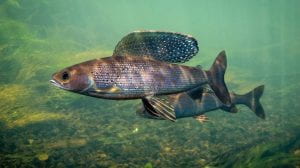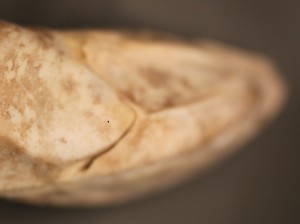Sure, those of us who wore glasses when we were younger may have been called “Hey, four eyes!”. But I bet none were ever taken to the level of “Hey, four eyed fish!”. ‘Cause that would be combining two insults, the discrimination against an ocular disability and the idea that you were kind of cold…or wishy-washy…well, anyway. I sometimes get to share the fact that I once caught a four-eyed fish, and would like to share some very interesting information about the species.
(Imagine me affecting a British accent here, to make my story sound more adventurous). “There I was, standing in the river with my doughty crew, when one of the young stalwarts excitedly shouted “Quatros ojos, quatros ojos!””. Yes, just a few feet away from me cruised the rare and dangerous (dangerous if you’re an insect, that is) Pacific four-eyed fish! Alright, enough of that…
In 1999 I accompanied members of my church on a mission trip to the area of Siguatepeque, Honduras, to assist in building cement block housing for victims of Hurricane Mitch (in 1998 Mitch was responsible for the death of at least 11,000 people in Central America) that caused a flood perhaps 40 feet deep in a valley near Siguatepeque. After the rest of the group left I stayed behind to travel to the Pan American School of Agriculture near Tegucigalpa,

where the fisheries instructor there graciously allowed me to accompany them on trips to waters near the school. The streams we sampled were the mainstem and tributaries of the Rio Choluteca, the major river on the Pacific slope of Honduras that winds through mountainous terrain until it empties into the Gulf of Fonseca (an estuary shared by El Salvador, Honduras and Nicaragua). At a site on the Choluteca, near the village of Zamorano, the school’s students and I seined up the Pacific Four-eyed Fish (Anableps dowi). This was a species I’d read about prior to making the trip, so when I heard the student’s cry I became quite excited!
The species was named for a Captain J. M. Dow, who skippered the steamer “Guatemala” of the Panama Railway Company. Captain Dow collaborated with two associates to send over specimens from over 1500 samples in Central America to the U.S. National and the British Museums. The reason for the Foureyes’ common name is actually due to the presence of two pupils in each eye, one in the upper and one in the lower half and separated by a band of tissue; enabling them to see above and below the water while they cruise at the surface of the water body. That ability makes the foureyed fish extremely difficult to catch with a seine since they are able to see you (or an eagle, or other bird of prey) coming from a long ways away. They are known to leap right over a seine and like other “topminnows” they dive down to the bottom to avoid capture. An effective method of capture is described as using a group of fishermen to drive a school of cuatros ojos toward a concealed individual waiting with a cast net that is thrown over the school, ensnaring a “bushel full” of the prey.
The eye is flattened on the top and rounded on the bottom half, with a thickening of the lens from the bottom to the top to adjust for the refractive differences in the two mediums. This structure has inspired at least one contact lense company to develop lenses that work extremely well both out of and in the water.
The Four-eyed fish eye. 1.Underwater retina 2.Lens 3. Air pupil 4. Tissue band 5. Iris 6. Underwater pupil 7. Air retina 8. Optic nerve
Swimming at the surface with the head exposed is relatively unusual for fishes in general, but species of the genus exhibit other oddities as well. Not only do the quatros ojos leap out of and skip along the surface of the water, but when they see terrestrial insects on the banks they will actually leap onto the shallow, inundated bankside areas to capture their prey.

Once they’re out of the water their mobility is severely limited since unlike eels they cannot locomote with a wriggling motion, nor can they push off with their tails to leap forward on land, and unlike mudskippers and the “walking” catfish their pectoral fins are unsuited to pulling themselves along. So although they may push themselves along with their tail and pectoral fins to chase their prey the extent to which they are able to do so is severely limited.
Another anomaly that characterizes anablepids is that their genital organs are oriented either to the left or right, thus they can reproduce only with mates having compatible organs. They share this character with the group of species to which they are said to be most closely related, the “One-Sided Livebearers”, or Jennysina. The functional significance of this anomaly is not known… The male of the species has a gonopodium; a modified anal fin ray that develops as the males mature and facilitates placement of the sperm into the oviduct, fertilizing the female’s eggs. The eggs are carried to term inside follicles in the female’s ovary but nourishment is provided by a yolk sac within the egg.
Anableps congregate in schools of up to 200 or so as juveniles, with their gregariousness decreasing with age until at adulthood they are as likely to be found as individuals as in small groups. Some of their known fish associates include characins, pimelodid catfish, poeciliids, atherinids, eleotrids, flatfishes and cichlids.
The Family Anablepidae is placed within the Order Cyprinodontiformes (the Pacific Foureyed Fish is the largest species in that order). That order contains a bounty of fascinating forms, with a wide variety of reproductive types, a plethora of adaptations to environments, and high importance in terms of biogeography. Cyprinodontiformes is made up of families that for the most part exclusively are either oviparous (egg laying), ovoviviparous (live-birthed from eggs) or viviparous (live-birthed from embryonic development without eggs). Species of the family Anablepidae are found in rivers and streams (some (such as the Pacific Four-eyed Fish) live and thrive in euryhaline and even marine areas) from Mexico to South America, and are ovoviviparous, or live bearers; similar to guppies and mosquitofish. Owing to the ability of many species to tolerate a wide range of salinities the cyprinodontoids are able to move along the coast from one stream to a neighboring stream. It is thought that this plasticity has enabled certain groups to disperse throughout southern Mexico to northern South America.
Anableps have an unusual and interesting lifestyle. They spend almost all of their time at the surface and rarely swim underwater. They will dive down when they spot a food item, though, using their large, paddle-like pectoral fins for a burst of speed. They will also leap onto mud and sand banks during periods of low-tide to snatch terrestrial insects. These fish have been observed lying in the sun, sometimes for several minutes, before pushing their way back into the water.
Four-Eyed Fish are moderately hardy, but they are comparatively large livebearers, growing to around a foot in length. Since they are surface swimmers they do best in a long, relatively shallow tank in (depending on the species) fresh to moderately brackish water. They are gregarious so don’t keep them singly or in pairs. They will probably do well with Sailfin Mollies, bottom-dwelling Gobies, Mudskippers, and even Orange Chromide Cichlids, Archer Fish and Monodactylus.


























